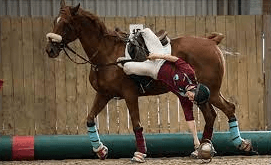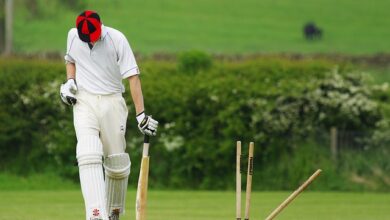How Can One Learn To Play Horseball?

Horseball, a thrilling equestrian sport that combines elements of basketball and rugby on horseback, offers individuals an exhilarating opportunity to engage in physical activity while strengthening their bond with horses. Learning how to play horseball requires mastering the basics of the game, understanding the rules and strategies involved, and developing essential riding skills. This article aims to provide a comprehensive guide for those seeking to embark on this exciting journey, offering invaluable insights into the fundamentals of horseball, tips for getting started, and advice for excelling in the sport.
In order to dive into the world of horseball, it is essential to grasp the basic principles that govern this unique discipline. Horseball involves two teams competing against each other on horseback with the objective of scoring points by throwing a ball through a hoop-shaped goal at either end of the field. Players must possess excellent riding skills as they maneuver their horses swiftly across the field while maintaining control over both their steed and the ball. Moreover, participants must adhere to specific rules regarding player interaction, such as passing or shooting techniques and defensive tactics. Understanding these fundamental aspects will provide individuals with a solid foundation upon which they can build their horseball expertise.
To begin their journey in learning how to play horseball, aspiring players should first focus on acquiring proficient riding abilities. This entails honing core equestrian skills such as balance, posture, coordination, and effective communication with horses through subtle cues. Developing strong leg muscles is crucial for maintaining stability while executing quick turns or sudden stops during gameplay. Additionally, riders must cultivate a deep understanding of horsemanship principles such as proper grooming techniques and equine care practices to ensure their horses’ well-being throughout training sessions and competitions.
By dedicating time and effort toward building these foundational riding skills alongside an unwavering commitment to teamwork and sportsmanship ethics inherent in horseball culture one can set themselves up for success in this captivating equestrian pursuit.
Basics of Horseball
The basics of horseball encompass understanding the rules, learning proper riding techniques, and developing strategies for effective ball control.
To start playing horseball, it is important to have the necessary equipment which includes a helmet, boots with heels, knee pads, and gloves for protection.
The rules and regulations of horseball are similar to those of basketball and rugby. The game is played with two teams of four players each who aim to score goals by throwing a ball into their opponent’s net while mounted on horses.
Players can pass the ball between teammates or carry it themselves while riding at full speed. However, they must always keep at least one hand on the reins for safety purposes.
Fouls such as dangerous riding or unsportsmanlike conduct can result in penalties or disqualification from the game.
Developing good riding techniques is essential in horseball as it requires balance, coordination, and agility to quickly maneuver around other players and effectively control the ball.
Strategies for effective ball control involve teamwork, communication, and anticipating the movements of both teammates and opponents.
By mastering these basics of horseball, individuals can lay a solid foundation for further skill development in this exhilarating sport that combines elements of equestrianism and team play.
Getting Started in Horseball
To begin the journey of acquiring horseball skills, it is advisable to initially focus on familiarizing oneself with the fundamentals of the sport.
This involves understanding the equipment used in horseball, such as the ball and the specialized saddle. The ball used in horseball is similar to a soccer ball but has handles on it, allowing players to grab and carry it while riding.
Read also: How Can One Learn Equestrian Vaulting?
The specialized saddle used in horseball provides extra security and support for the rider during fast-paced maneuvers.
In addition to equipment, it is crucial to learn and understand the rules of horseball. Horseball combines elements from various equestrian sports like polo and basketball, making it important to grasp concepts such as passing, shooting, and scoring goals.
By gaining knowledge about these fundamental aspects of horseball, individuals can lay a strong foundation for further skill development in this exhilarating sport.
Tips for Excelling in Horseball
This discussion will focus on three key points for excelling in horseball:
- Building teamwork and communication,
- Developing strategy and tactics,
- Improving coordination and agility on horseback.
Effective teamwork and communication are essential in horseball as it is a fast-paced team sport requiring quick decision-making and coordination among players.
Developing strategic thinking and tactical skills is crucial to outmaneuvering opponents and scoring goals.
Additionally, honing coordination and agility on horseback is important for executing precise movements during gameplay.
Building Teamwork and Communication
Developing effective teamwork and communication skills is crucial in learning to play horseball, as research has shown that teams with strong cohesion are more likely to achieve success on the field.
Building trust among team members is essential for creating a solid foundation for teamwork. Trust can be built through open and honest communication, where team members feel comfortable expressing their thoughts and ideas without fear of judgment.
Effective communication is also vital in horseball, as it allows players to coordinate their movements and make split-second decisions during fast-paced gameplay. Clear communication ensures that everyone on the team understands their role and responsibilities, leading to better coordination and overall performance.
Practicing drills that focus on teamwork and communication can help players develop these skills, such as passing exercises or simulated game situations where players must work together to achieve a common goal.
By emphasizing building trust and effective communication, individuals can enhance their ability to work cohesively with their teammates in horseball, ultimately leading to improved performance on the field.
Developing Strategy and Tactics
The development of effective strategy and tactics is essential for achieving success in the game of horseball. To excel in this sport, players must not only possess strong horsemanship skills but also have a deep understanding of offensive plays and defensive strategies.
Here are four key elements to consider when developing strategy and tactics in horseball:
- Understanding the rules: To create effective offensive plays and defensive strategies, players must first have a thorough understanding of the rules of horseball. This includes knowing how goals are scored, what constitutes a foul, and how fouls are penalized. By having a solid grasp of the rules, players can make informed decisions on the field.
- Analyzing opponents: Another crucial aspect of developing strategy and tactics is analyzing opponents’ strengths and weaknesses. By studying their playing style, preferred formations, and individual player abilities, teams can identify areas where they can exploit weaknesses or neutralize strengths. This knowledge allows them to tailor their offensive plays and defensive strategies accordingly.
- Creating cohesive offensive plays: Developing effective offensive plays involves creating structured patterns that allow players to work together seamlessly towards scoring goals. This requires coordination between riders and horses, quick decision-making skills, and precise execution of passes and shots on goal.
- Formulating effective defensive strategies: Equally important as offense is defense in horseball. Teams must develop strategies to prevent opposing teams from scoring by using techniques such as marking opponents closely, intercepting passes, or blocking shooting lanes.
By focusing on these aspects – understanding the rules, analyzing opponents’ strengths/weaknesses, creating cohesive offensive plays, and formulating effective defensive strategies – players can enhance their overall performance in horseball games by implementing well-thought-out plans that increase their chances of success while maintaining a sense of freedom on the field.
Improving Coordination and Agility on Horseback
Improving coordination and agility on horseback requires riders to seamlessly synchronize their movements with the rhythm of their horses, akin to a symphony conductor guiding each section of the orchestra in perfect harmony.
One way to enhance these skills is through specific equestrian fitness exercises that target the rider’s balance, core strength, and flexibility.
These exercises can include activities such as lunges, squats, and planks, which help develop stability and strengthen the muscles necessary for maintaining a solid position on the horse.
Additionally, horseback riding itself provides numerous benefits for coordination and agility.
The constant adjustments needed to maintain balance while riding a moving animal require riders to engage their core muscles, improve their reflexes, and refine their proprioception (awareness of one’s body in space).
This not only enhances coordination but also develops quick thinking and adaptability in responding to unexpected situations.
Ultimately, by incorporating equestrian fitness exercises into their training routine and regularly engaging in horseback riding activities, individuals can significantly improve their coordination and agility on horseback while enjoying the freedom that comes from this exhilarating sport.
Frequently Asked Questions
What are the rules and regulations of horseball?
Horseball is a fast-paced equestrian sport that combines elements of polo, rugby, and basketball. It involves two teams of four players who score by throwing a ball through a hoop. Horseball can be learned through local equestrian clubs and organizations that offer training programs. It provides numerous benefits for riders with disabilities, including improved balance, coordination, and confidence. Additionally, horseball promotes physical fitness, teamwork, and sportsmanship.
What equipment is necessary for playing horseball?
What equipment is necessary for playing horseball? To engage in this equestrian sport, players require specific gear including a horse, a ball, and protective equipment such as helmets, knee and elbow pads.
Are there any specific horse breeds that are better suited for horseball?
Different horse breeds can excel in horseball due to their agility, speed, and endurance. Training techniques such as teaching ball control, maneuvering skills, and teamwork are crucial for mastering the game.
How can one improve their riding skills to excel in horseball?
Improving riding techniques involves developing effective communication with horses. By mastering the art of subtle cues, riders can guide their horses with grace and precision, creating a harmonious partnership that allows for seamless performance in horseball.
Are there any common injuries associated with playing horseball, and how can they be prevented?
Common horseball injuries include falls, sprains, strains, and concussions. To prevent these injuries, proper safety equipment such as helmets and protective gear should be worn. Regular conditioning and training to improve balance and coordination are also crucial in preventing injuries in horseball.
Conclusion
In conclusion, learning to play horseball requires a strong foundation in the basics of the sport and a commitment to improving one’s skills. By understanding the rules, techniques, and strategies involved in horseball, individuals can get started on their journey towards becoming proficient players.
It is important to find a reputable coach or club that offers training sessions and opportunities for practice. Additionally, participating in clinics or workshops can provide valuable insights and guidance from experienced players.
To excel in horseball, it is crucial to develop a deep understanding of the game’s intricacies and master the necessary skills. This includes honing riding abilities, such as balance, control, and agility on horseback. Furthermore, one must become adept at handling the ball with precision while navigating through the field alongside other players. Regular practice sessions are essential for refining these skills and building teamwork with fellow teammates.
In summary, learning to play horseball requires dedication and perseverance. It is important to immerse oneself in the sport by gaining knowledge of its fundamentals and seeking opportunities for growth through coaching, training sessions, clinics, and workshops. By consistently practicing riding skills and ball handling techniques while fostering teamwork with other players, individuals can enhance their performance in this exhilarating equestrian sport. As Winston Churchill famously said: ‘Success is not final; failure is not fatal: it is the courage to continue that counts.’



